Lower Abdominal Fullnessaccording to TCM
Symptom families: Lower Abdominal Pain and Discomfort, Abdominal Distension and Fullness
Sub-symptom(s): Lower Abdominal Fullness And Pain
What is Lower Abdominal Fullness?
Lower abdominal fullness is a sensation often described as a feeling of pressure or tightness in the hypogastric region, below the umbilicus. This symptom can be both uncomfortable and concerning, reflecting various underlying conditions that may require attention.
It's not just a matter of physical discomfort but can also signal disruptions in the body's natural processes. This symptom can manifest alone or accompany other symptoms, providing key insights into the body's internal state.
How does TCM View Lower Abdominal Fullness?
Traditional Chinese Medicine (TCM) approaches lower abdominal fullness not as an isolated symptom but as a sign of imbalance within the body's energetic systems. TCM theory suggests that such physical manifestations arise when the flow of Qi (energy), Blood, or Body Fluids is obstructed or when there is an imbalance between the body's fundamental substances.
Identifying the specific pattern of disharmony causing the symptom is crucial for TCM practitioners, as it guides the selection of the most appropriate and effective treatment methods.
Root Causes of Lower Abdominal Fullness in TCM
In TCM, lower abdominal fullness is often attributed to conditions such as Greater Yang Accumulation of Blood, characterized by symptoms like hypogastric fullness and restlessness, and Damp-Heat in the Liver, presenting as hypogastrium fullness with a possible bitter taste in the mouth.
These patterns highlight the importance of the Liver and Bladder's roles in maintaining harmony within the body's internal environment. Treatment focuses on addressing the root cause, whether it's moving Stagnant Blood, dispelling Damp-Heat, or restoring the balanced flow of Qi.
Explore below more details about what might cause Lower abdominal fullness according to TCM.
- By Syndrome
- By Organ
- Heat
- Dampness
- Bladder
- Liver
Heat
In TCM "Heat" signifies an excess of Yang energy, leading to an imbalance where heat predominates over the body's cool Yin aspects. This condition is metaphorically akin to an internal over-heating. Symptoms indicative of Heat can include feelings of warmth, fever, sweating, irritability, red face, thirst with a preference for cold drinks, and a rapid pulse. The tongue may appear red with a yellow coating. Unlike the common interpretation of heat in terms of temperature, in TCM, it represents a state of hyperactivity or inflammation in the body.... see more
Heat Patterns That Can Lead to Lower Abdominal Fullness
Common Symptoms: Hematuria Urinary Burning Dark Urine Fever Lower Abdominal Distension Restlessness Hypochondrial Fullness With Warmth Relief Abdominal Fullness
| Pattern Name | Relevant Symptoms | Relevant Formulas |
|---|---|---|
| Greater Yang Accumulation of Blood | Hypogastric fullness, Lower abdominal distension, Lower abdominal fullness, Hematuria, Restlessness | Tao He Cheng Qi Tang |
| Damp-Heat in the Liver | Hypogastrium fullness, Hypochondrial fullness with warmth relief, Abdominal fullness, Lower abdominal fullness, Bitter taste in the mouth, Sticky taste in the mouth, Lack of appetite, Nausea, Feeling of heaviness, Yellow vaginal discharge, Vaginal itching, Vulvar eczema, Vulvar sores, Bleeding between periods, Midcycle bleeding pain, Red and swollen scrotum, Red and swelling genital, Papules, Itchy vesicular rashes, Urinary dysfunction, Urinary burning, Dark urine... see more | Long Dan Xie Gan Tang | Yin Chen Hao Tang |
| Damp-Heat in the Bladder | Hypogastric fullness and pain, Frequent and urgent urination, Urinary burning, Urination stopping in the middle of flow, Dark urine, Cloudy urine, Hematuria, Fever, Dry mouth without desire to drink, Lower abdominal fullness and pain, Feeling hot... see more | Ba Zheng San |
Dampness
"Dampness" in TCM is a concept that describes a pattern of disharmony where the body accumulates excess moisture. Imagine the heavy, sticky feeling you get on a very humid day; that's similar to what dampness feels like internally. It can manifest as a sense of heaviness, bloating, sluggishness, or even a foggy mind. This condition is often thought to arise from environmental factors like living in a damp place, dietary habits that promote moisture in the body, or internal imbalances that hinder the body's ability to process fluids properly. In TCM, dampness can obstruct the normal flow of energy and fluids in the body, leading to various symptoms.... see more
Dampness Patterns That Can Lead to Lower Abdominal Fullness
Common Symptoms: Urinary Burning Dark Urine Fever Hypochondrial Fullness With Warmth Relief Abdominal Fullness Bitter Taste In The Mouth Sticky Taste In The Mouth Lack Of Appetite
| Pattern Name | Relevant Symptoms | Relevant Formulas |
|---|---|---|
| Damp-Heat in the Liver | Hypogastrium fullness, Hypochondrial fullness with warmth relief, Abdominal fullness, Lower abdominal fullness, Bitter taste in the mouth, Sticky taste in the mouth, Lack of appetite, Nausea, Feeling of heaviness, Yellow vaginal discharge, Vaginal itching, Vulvar eczema, Vulvar sores, Bleeding between periods, Midcycle bleeding pain, Red and swollen scrotum, Red and swelling genital, Papules, Itchy vesicular rashes, Urinary dysfunction, Urinary burning, Dark urine... see more | Long Dan Xie Gan Tang | Yin Chen Hao Tang |
| Damp-Heat in the Bladder | Hypogastric fullness and pain, Frequent and urgent urination, Urinary burning, Urination stopping in the middle of flow, Dark urine, Cloudy urine, Hematuria, Fever, Dry mouth without desire to drink, Lower abdominal fullness and pain, Feeling hot... see more | Ba Zheng San |
Bladder
In TCM the Bladder plays a crucial role beyond its basic function of storing and excreting urine. It is intimately connected with the Kidney system, helping to regulate the body's water balance and being a key component in the processing and elimination of fluids. The Bladder also influences the lower part of the body and the back. When it malfunctions or is imbalanced in TCM, it can lead to urinary issues like frequent urination, incontinence, or painful urination. Additionally, there may be problems related to its meridian pathway, such as lower back pain, stiffness, or weakness in the legs. The Bladder’s condition in TCM can also reflect emotional states, with imbalances potentially leading to feelings of fear or anxiety.... see more
Bladder Patterns That Can Lead to Lower Abdominal Fullness
Common Symptoms: Hematuria Lower Abdominal Distension Restlessness Frequent And Urgent Urination Urinary Burning Urination Stopping In The Middle Of Flow Dark Urine Cloudy Urine
| Pattern Name | Relevant Symptoms | Relevant Formulas |
|---|---|---|
| Greater Yang Accumulation of Blood | Hypogastric fullness, Lower abdominal distension, Lower abdominal fullness, Hematuria, Restlessness | Tao He Cheng Qi Tang |
| Damp-Heat in the Bladder | Hypogastric fullness and pain, Frequent and urgent urination, Urinary burning, Urination stopping in the middle of flow, Dark urine, Cloudy urine, Hematuria, Fever, Dry mouth without desire to drink, Lower abdominal fullness and pain, Feeling hot... see more | Ba Zheng San |
Liver
In TCM the Liver is viewed as the organ responsible for the smooth flow of Qi, Blood, and emotions throughout the body. It plays a key role in regulating mood, storing blood, supporting digestion, and ensuring the health of tendons and eyes. When the Liver malfunctions or is imbalanced in TCM, it can lead to a range of issues such as irritability, mood swings, menstrual irregularities, eye problems, and muscular stiffness or pain. A malfunctioning Liver in TCM reflects not only physical disturbances but also emotional and mental disharmony, emphasizing the holistic approach of TCM in addressing health and wellness.... see more
Liver Patterns That Can Lead to Lower Abdominal Fullness
| Pattern Name | Relevant Symptoms | Relevant Formulas |
|---|---|---|
| Damp-Heat in the Liver | Hypogastrium fullness, Hypochondrial fullness with warmth relief, Abdominal fullness, Lower abdominal fullness, Bitter taste in the mouth, Sticky taste in the mouth, Lack of appetite, Nausea, Feeling of heaviness, Yellow vaginal discharge, Vaginal itching, Vulvar eczema, Vulvar sores, Bleeding between periods, Midcycle bleeding pain, Red and swollen scrotum, Red and swelling genital, Papules, Itchy vesicular rashes, Urinary dysfunction, Urinary burning, Dark urine... see more | Long Dan Xie Gan Tang | Yin Chen Hao Tang |
TCM Herbal Formulas for Lower Abdominal Fullness
For treating lower abdominal fullness, TCM relies on specific herbal formulas designed to target the underlying patterns of imbalance. Tao He Cheng Qi Tang, effective for Blood Stagnation, and Long Dan Xie Gan Tang, suitable for clearing Damp-Heat from the Liver, are among the recommended remedies.
These formulas contain key ingredients like Peach Kernels and Chinese Gentian, known for their properties to invigorate Blood and clear Heat, respectively, demonstrating TCM's nuanced approach to restoring health.
Explore below some TCM herbal formulas used to address lower abdominal fullness, organized by cause and by formula type.
- By Cause
- By Formula Type
- Heat
- Dampness
- Formulas that clear heat and expel dampness
- Formulas that invigorate blood and dispel blood stagnation
- Formulas that clear heat from the organs
Top Formula for Heat:
Tao He Cheng Qi Tang
Suitable for Heat patterns that may cause lower abdominal fullness, such as Greater Yang Accumulation of Blood
Learn moreAll Formulas Recommended for Lower Abdominal Fullness Caused by Heat
| Formula | Patterns Suitable For |
|---|---|
| Tao He Cheng Qi Tang | Greater Yang Accumulation of Blood |
| Long Dan Xie Gan Tang | Damp-Heat in the Liver |
| Yin Chen Hao Tang | Damp-Heat in the Liver |
| Ba Zheng San | Damp-Heat in the Bladder |
Top Formula for Dampness:
Long Dan Xie Gan Tang
Suitable for Dampness patterns that may cause lower abdominal fullness, such as Damp-Heat in the Liver
Learn moreAll Formulas Recommended for Lower Abdominal Fullness Caused by Dampness
| Formula | Patterns Suitable For |
|---|---|
| Long Dan Xie Gan Tang | Damp-Heat in the Liver |
| Yin Chen Hao Tang | Damp-Heat in the Liver |
| Ba Zheng San | Damp-Heat in the Bladder |
Formulas that clear Heat and expel dampness
These formulas are suitable for some lower abdominal fullness-causing patterns like Damp-Heat in the Liver.
One such formula is Yin Chen Hao Tang, with virgate wormwood as a key herb.
Other formulas of this category are listed in the table below.
All "formulas that clear heat and expel dampness" recommended for lower abdominal fullness
| Formula | Patterns Suitable For (if applicable) |
|---|---|
| Yin Chen Hao Tang | Damp-Heat in the Liver |
| Ba Zheng San | Damp-Heat in the Bladder |
Formulas that invigorate Blood and dispel Blood Stagnation
These formulas are suitable for some lower abdominal fullness-causing patterns like Greater Yang Accumulation of Blood.
One such formula is Tao He Cheng Qi Tang, with peach kernel as a key herb.
Formulas that clear Heat from the Organs
These formulas are suitable for some lower abdominal fullness-causing patterns like Damp-Heat in the Liver.
One such formula is Long Dan Xie Gan Tang, with chinese gentian as a key herb.
Acupoints for Lower Abdominal Fullness
Acupuncture is another cornerstone of TCM treatment, with specific acupoints like Baohuang BL-53 and Henggu KID-11 being instrumental in managing lower abdominal fullness. These points are selected for their ability to regulate Qi in the Lower Burner, move Qi and Blood, resolve Dampness, and clear Heat, showcasing acupuncture's capacity to address the physical symptoms and the energetic imbalances contributing to the condition.
Explore below some acupoints used to address lower abdominal fullness, organized by meridian.
- By Meridian
- Bladder Channel
- Kidney Channel
- Gall Bladder Channel
- Liver Channel
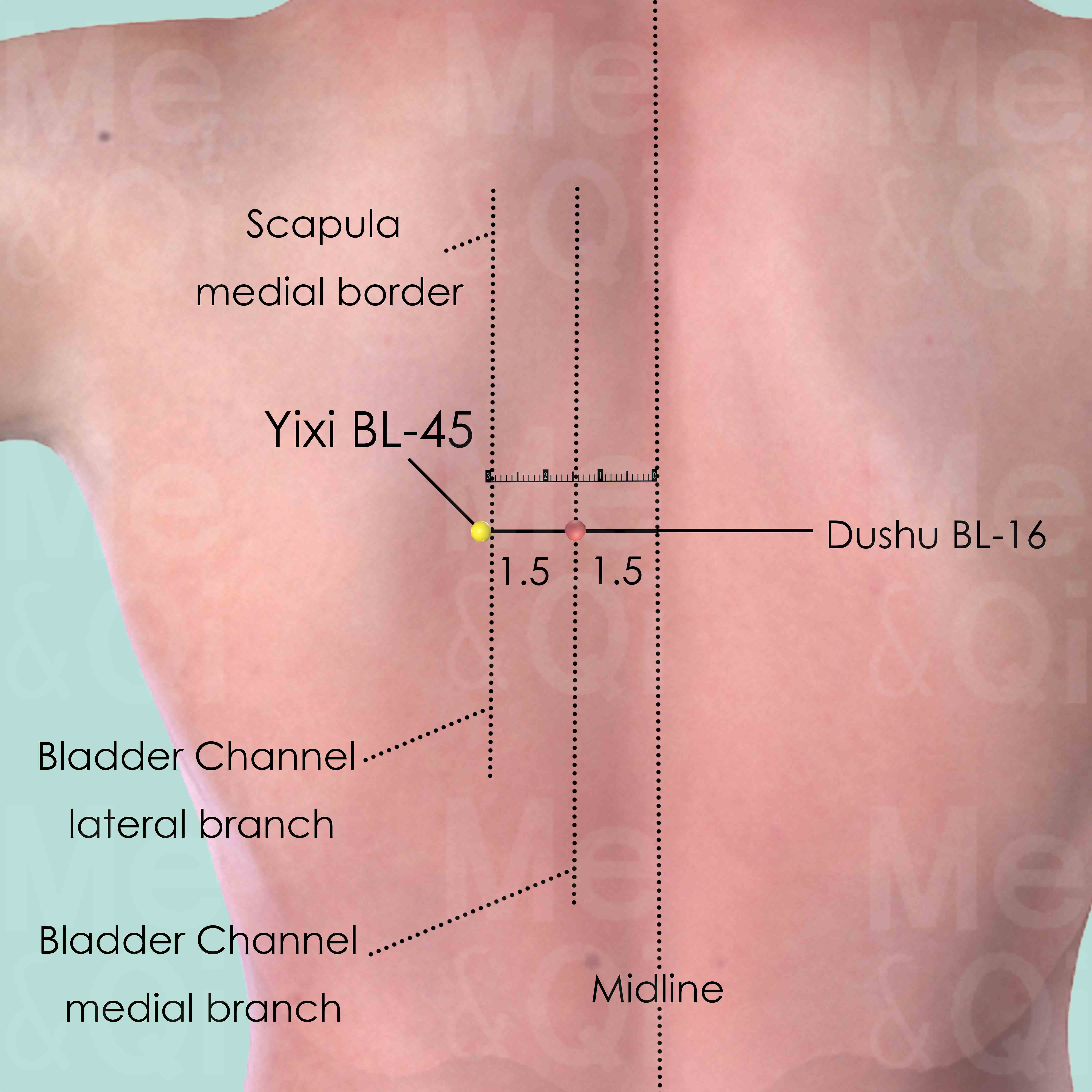
Yixi BL-45
3 cun (about 4 finger-breadths) lateral to the lower border of the spinous process of the 6th thoracic vertebra (T6).
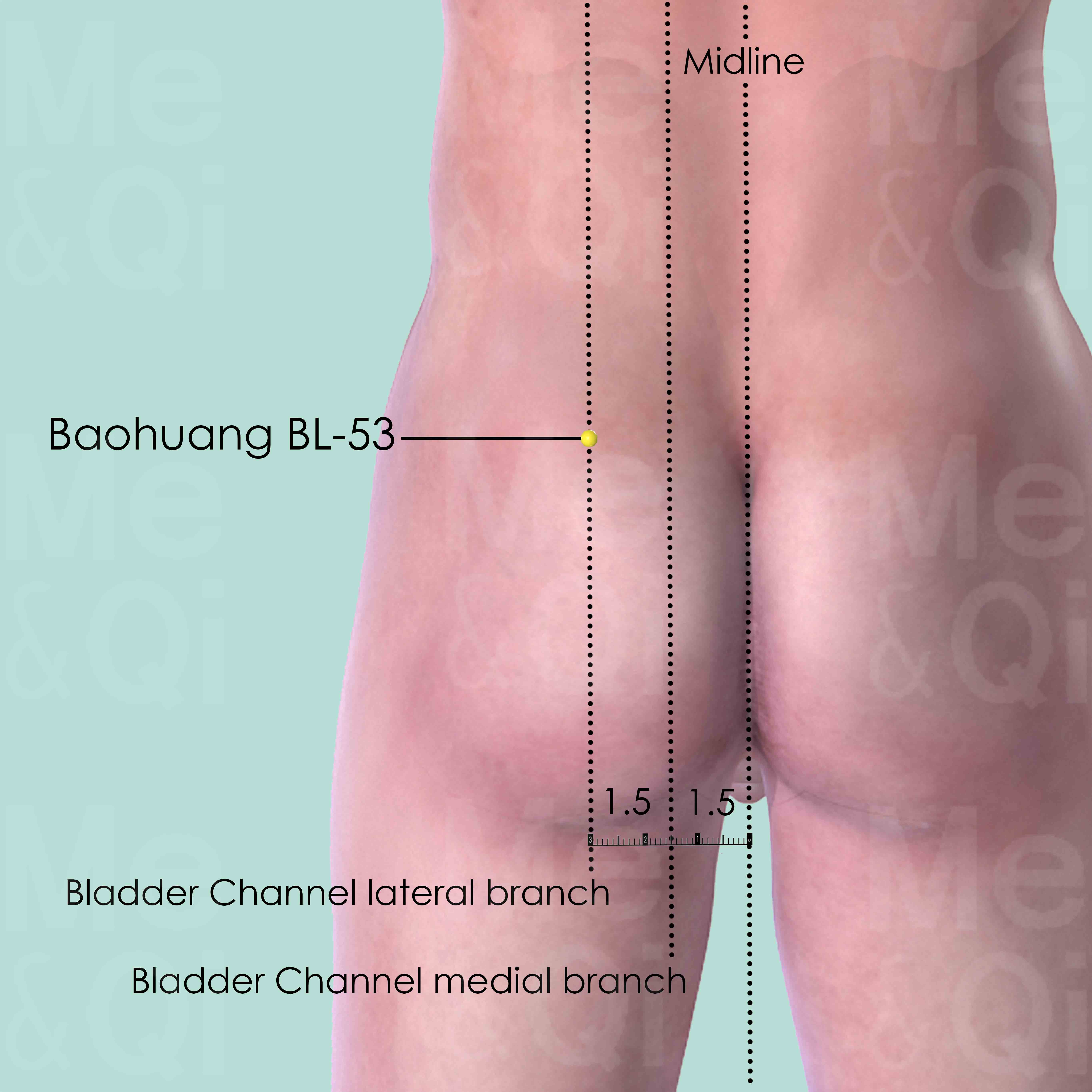
Baohuang BL-53
At the level of the 2nd posterior sacral foramen, 3 cun lateral to the posterior midline.
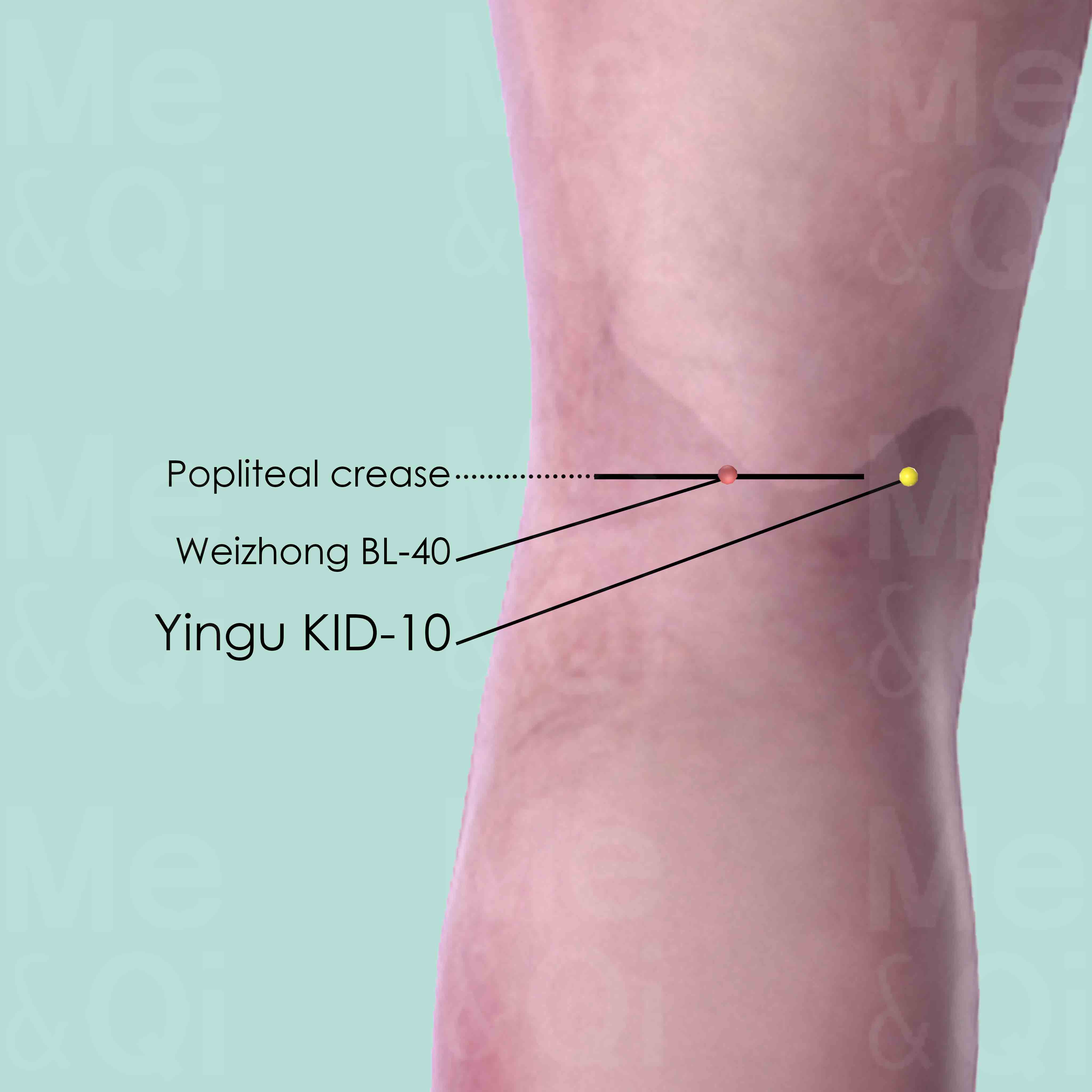
Yingu KID-10
On the medial side of the popliteal fossa, level with Weizhong BL-40, between the tendons of semitendinosus and semimenbranosus muscle when the knee is flexed.
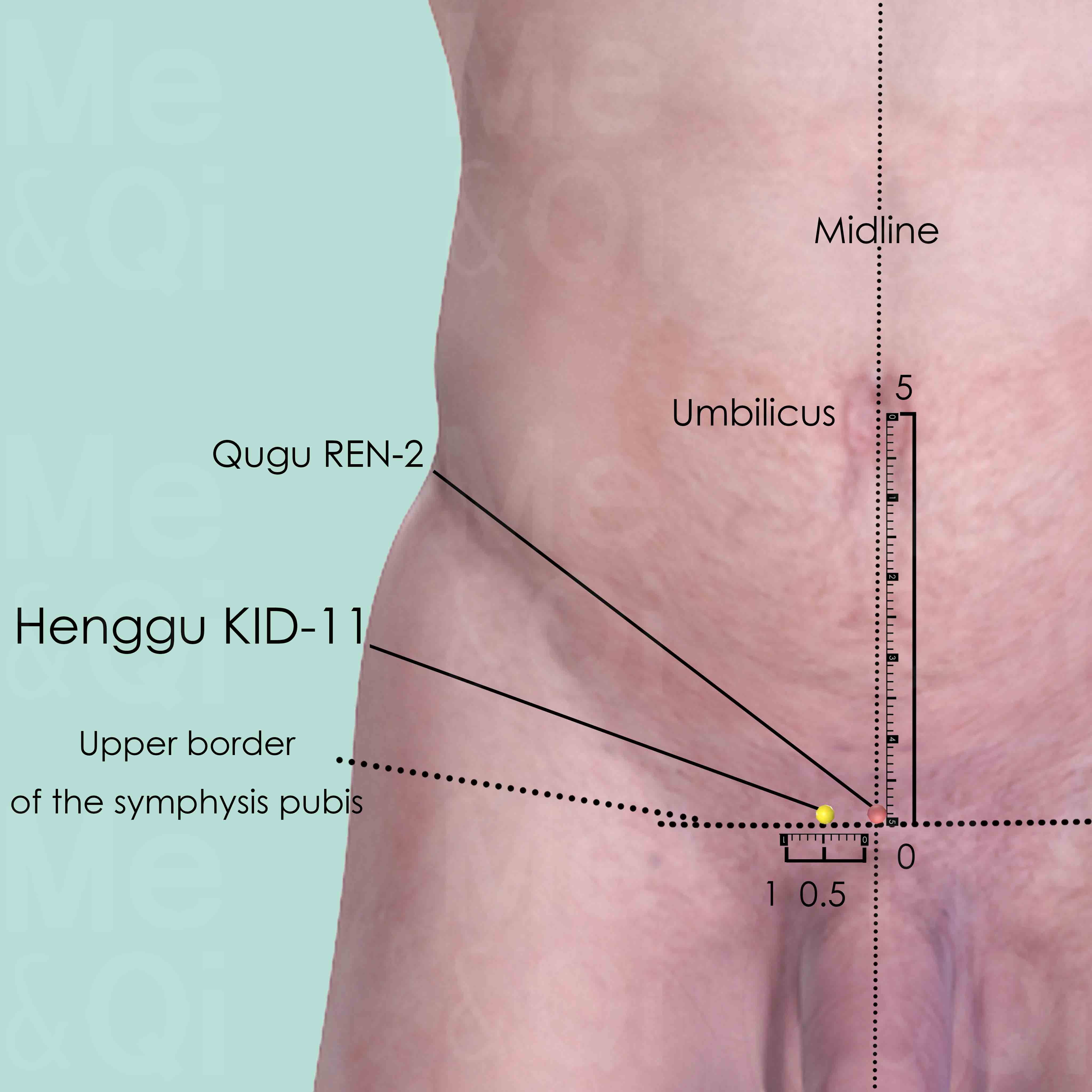
Henggu KID-11
5 cun below the umbilicus, on the upper border of symphysis pubis, 0.5 cun lateral to the anterior midline. It is at the same level as Qugu REN-2 which is at the anterior midline.
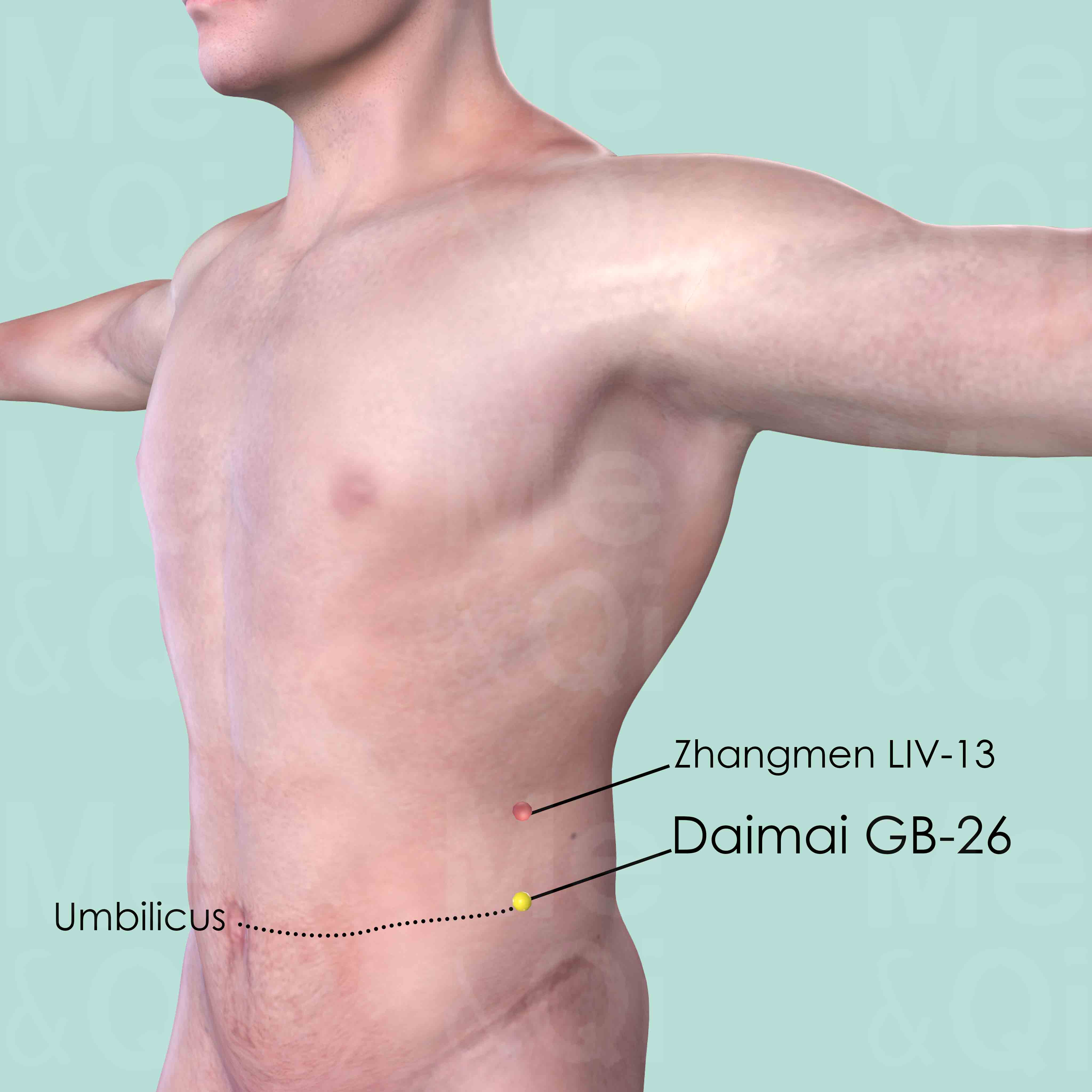
Daimai GB-26
Level with the umbilicus, directly below Zhangmen LIV-13 which is on the free end of the 11th rib.
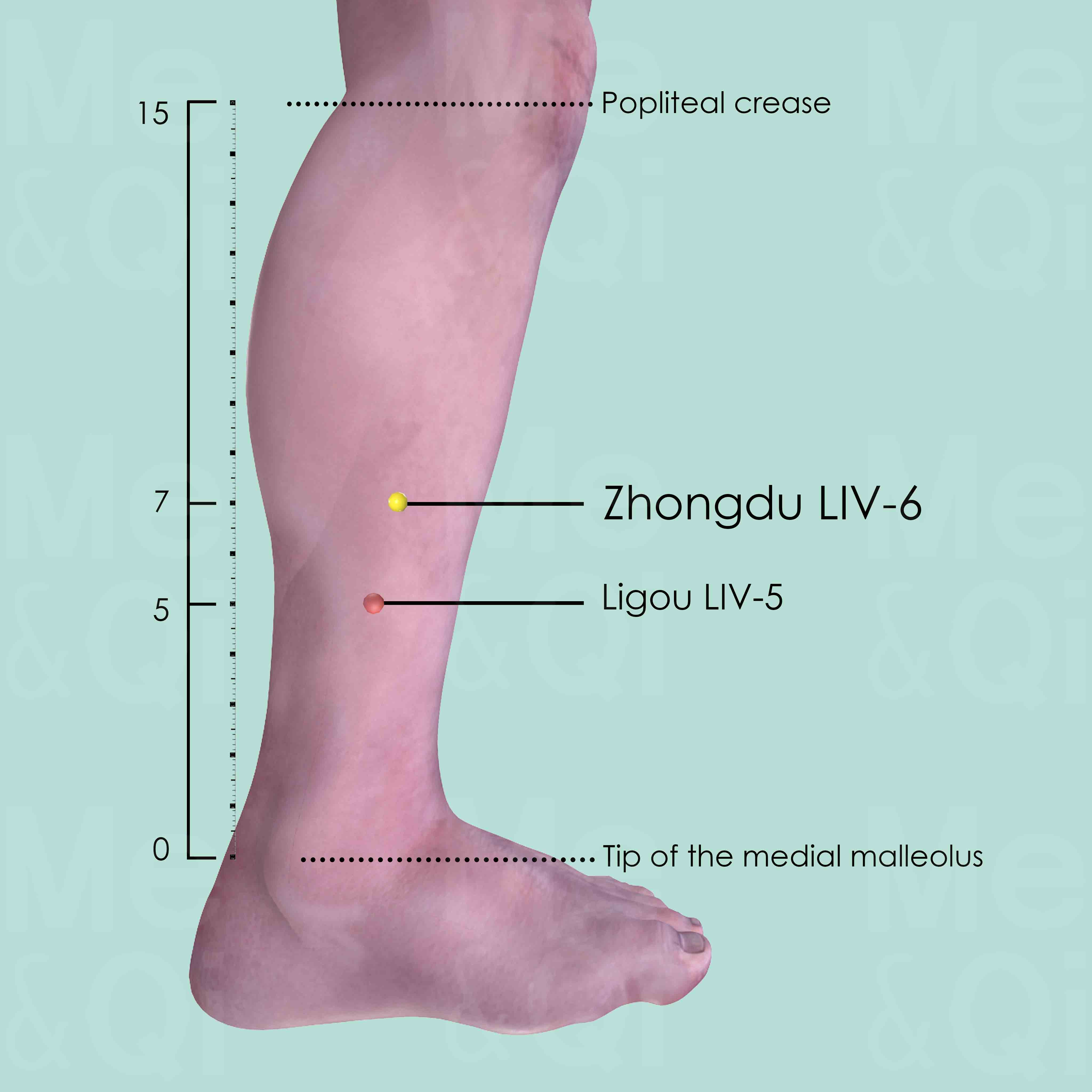
Zhongdu LIV-6
7 cun above the tip of the medial malleolus, or 2 cun above Ligou LIV-5, on the medial aspect and posterior to the medial crest of the tibia.
